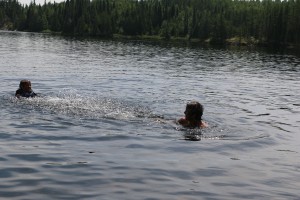Come Play in the BWCA
Outdoor play is good for you and your kids. Why not plan an end of the summer BWCA trip where you can play outdoors together? Think of all of the fun things you can do while you’re on a canoe camping trip with a kid.
- Swimming and tons of associated water games like Marco Polo
- Stick and pine cone baseball
- Hackey Sack with a pine cone or real one
- Skipping rocks
- Catching crayfish or regular fish
- Finding spiders, frogs and other fun insects
- Stargazing and making up silly songs around the campfire
- I Spy
The games you can play are endless just like the benefits of time in the wilderness are too numerous to count. If you can’t make it to the BWCA then at least make some time to play outdoors before school starts whether or not you have a kid.

Nature play at home
Being outdoors is great for kids. Studies summarized by the National Wildlife Federation show that kids who spend regular time playing outdoors are more likely to be:
Great students and learners
Able to get along well with others
More creative and curious
Good problem solvers
Generally healthier and happier overall!
As a parent of two young boys, I can also tell you that nature play is relaxing and fun! Here are the basics, as well as some great resources to get you started.
Authentic nature play is unstructured, imaginative, and open-ended. It encourages experimentation and observation. It also includes an element of age-appropriate risk-taking. Risk taking can be as simple as climbing, balancing, and jumping from a new height.
While away-from-home nature areas might create some wonderful memories, you don’t have to travel away from your home to get the benefits of nature play. With a few simple additions, a backyard can include lots of the “good stuff” that is a part of nature play.
Nature play at home can include things like:
Loose parts, like piles of rocks, sticks, or leaves
Construction materials, like sticks, poles, straw bales, tarps, boxes, and 2x4s
Tools, like shovels, buckets, and rope
Water
Mud, dirt, or sand
Hiding spaces
Plants
Balance logs and stumps
Small characters or props for ‘fairy villages’
Swings, hammocks, and other places for relaxing
One of the most inspirational guides I’ve read about nature play at home is the National Wildlife Federation’s guide for Nature Play at Home. Every time I look at it, I get new ideas! You can also find great resources on the Minnesota DNR’s Arbor Month page.
There are small adjustments to be made as you let your kids play in this way. For example, I’ve learned not to worry when the sand leaves the sand box. I’ve decided to allow the kids to dig a big hole in the yard, but I chose where to let it happen. I’ve let the kids harvest ‘herbs’ as a part of their imaginative games even if it means some of my plants take a beating. And, as the parts, pieces, forts, and rock piles move around it is certainly a bit messier than my pre-kid yard, but not any messier than most of my life. I smile (and take a seat on the porch steps) when I see how engaged and focused my sons and their friends can be in this environment.
Small spaces work too
Remember, even when space is limited there are creative nature play ideas to adopt. Balconies are usually big enough for potted plants, a fairy village, a vine tee pee growing out of pots, or a small sand box.
Ideas for winter
Snow play is a wonderful form of nature play. Mittened hands can still play with loose parts, branches, stumps and ropes. When the cold brings you in, bring nature play inside:
Bring loose parts inside. Fill baskets with rocks, tree slices, leaves, acorns, and other things you collect. They can be used as props for any storyline your young ones create.
Make an indoor sandbox.
Bring snow inside in a tub to play with. Try painting it with watercolors, like this.

Leave a Reply
You must be logged in to post a comment.